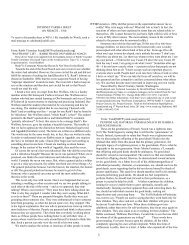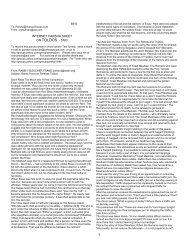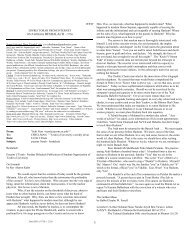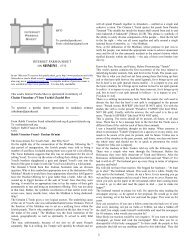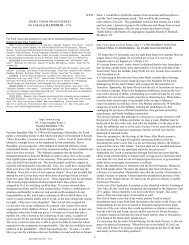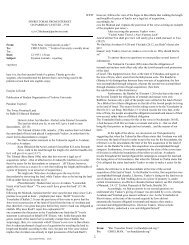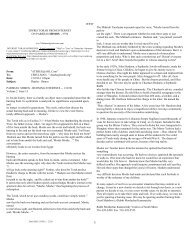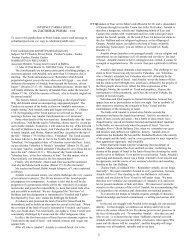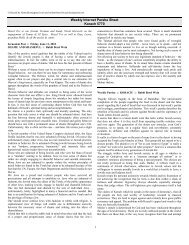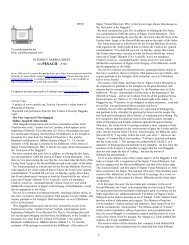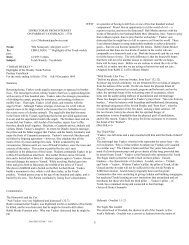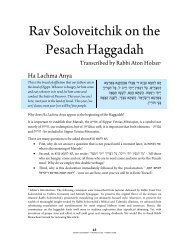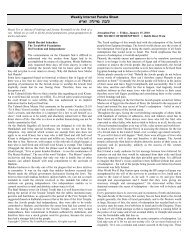ON PARSHAS TAZRIA-METZORA - 5756 - Internet Parsha Sheet
ON PARSHAS TAZRIA-METZORA - 5756 - Internet Parsha Sheet
ON PARSHAS TAZRIA-METZORA - 5756 - Internet Parsha Sheet
You also want an ePaper? Increase the reach of your titles
YUMPU automatically turns print PDFs into web optimized ePapers that Google loves.
united it with the Essence of G-d." Instead, "when a man does it<br />
(studies), in the first place he does so with himself in mind."<br />
On the other hand, when the Torah was given, the order was reversed.<br />
Its devolution from the spirituality of G-d to the physical situation<br />
of man was, as it were, a descent from higher to lower.<br />
In the passage in Proverbs which describes the wisdom of the Torah,<br />
it first says: "Then I was by Him, as one brought up with Him, and I<br />
was daily His delight." Only subsequently were "my delights with the<br />
sons of men."<br />
The Torah reached down from the heights of G-d to become the<br />
possession of man. And we in our learning retrace its path, ascending<br />
from our physical situation to spiritual closeness with G-d.<br />
This order of learning is mirrored in the structure of the Torah<br />
itself.<br />
This is why the laws concerning animals are placed first. To sanctify<br />
the animal world, by distinguishing the impure from the pure, is<br />
relatively simple. The problem of sin does not arise in their case.<br />
But for man to sanctify himself, given his capacity for wrongdoing, is<br />
far harder. Thus the laws of human conduct come last. Not because of<br />
man's innate superiority to the animals, but because of his<br />
deficiencies.<br />
This, too, is Rav Simlai's opinion as to why he was created last: "So<br />
that if he becomes too proud, he may be reminded that the gnats<br />
preceded him in the order of creation."<br />
RAV SIMLAI - THE MAN AND HIS OPINI<strong>ON</strong>S<br />
We can now see the connection between Rav Simlai's comment, that just<br />
as man was created last so his legislation comes last in the Torah,<br />
and the character of Rav Simlai himself.<br />
A virtue can be possessed in two ways. It can be won by effort, or it<br />
can be innate or fortuitous. Each has its advantages. An innate or<br />
unworked-for virtue has no natural limits. It is like the difference<br />
between talent and expertise. An inborn talent may be unlimited;<br />
expertise, painfully acquired, can never quite match it. But in its<br />
inwardness, the virtue reached by effort surpasses the virtue which is<br />
innate. One is always more closely involved with what one has earned<br />
than with what one has been given.<br />
This distinction underlies the two contrasting explanations of man's<br />
place as the last of the works of creation: The first that he is the<br />
highest, the second that he is the lowest, of creatures.<br />
In innate capacities, he is the highest. From birth, before he has<br />
begun to serve G-d, he is nonetheless possessed of a soul which is<br />
literally a part of G-d. This he retains, together with an underlying<br />
faith, even if he turns away from the Divine will. But in those<br />
virtues which he acquires through the effort of service, at the outset<br />
he is no better than the rest of creation.<br />
In fact, what is most readily apparent is his physical nature, his<br />
lack of restraint, his capacity for sin. The powers of the soul are as<br />
yet undisclosed. They need to be brought to the surface by effort in<br />
the service of G-d. Hence the second opinion, that man was created<br />
last to be reminded that even the gnat is in this one respect prior to<br />
him.<br />
The connection between this view and its author is this: Rav Simlai<br />
did not have an illustrious ancestry.<br />
The story is told in the Talmud that he came to Rabbi Jochanan and<br />
asked him to teach him the Book of Genealogies. But Rabbi Jochanan<br />
refused, because (according to Rashi) his lineage was undistinguished.<br />
Therefore Rav Simlai, unable to lay claim to inherited virtue,<br />
appreciated the value and importance of effort and acquired virtue.<br />
This explains his reading of the order of creation. When man is<br />
created, he has no acquired distinctions except the disposition to<br />
sin. He was made last because at that stage he is the lowest of<br />
beings. This also explains why human law should be called Tazria<br />
("be delivered"). For the process from conception to birth is a<br />
symbol of effort, of bringing to fruition, in other words of "labor"<br />
Doc#:DS3:217355.1 2331<br />
10<br />
in both its senses.<br />
There is an additional symbolism in the phrase "if a woman be<br />
delivered."<br />
The male and female elements in procreation represent respectively the<br />
"spiritual awakening from above" (i.e., the Divine initiative) and<br />
"from below" (the human initiative). And service, effort, struggle are<br />
the forms which the human initiative takes.<br />
The Two Faces of Man<br />
There is a principle expressed in the Lecha Dodi prayer that "last in<br />
action, first in thought." Thus man, who was created last, was the<br />
original intention behind the whole enterprise of creation.<br />
Both opinions agree with this, that man is the apex of created life.<br />
But one side of the argument sees his stature in terms of his innate<br />
essence: His Divine soul. The other sees it in terms of his potential<br />
achievement through the effort of serving G-d, while viewing man in<br />
himself as the lowest of beings. This view, which is Rav Simlai's,<br />
sees the two faces of man ("Adam" in Hebrew). On the one hand he is<br />
formed from the dust of the earth ("Adamah"); on the other, he is<br />
capable of becoming Divine ("Adameh la-Elyon" -"I will resemble G-d").<br />
This is his essential capacity - to transform himself completely, from<br />
a natural to a spiritual being.<br />
SERVICE AND CREATIVITY<br />
The name "Tazria" therefore symbolizes "avodah," man's service of G-d.<br />
It also suggests the importance of that service. For when a woman<br />
conceives a child and it grows in the womb, an entirely new being is<br />
brought into existence. The birth of the child merely reveals this<br />
creation, which was wrought at the moment of conception. And when man<br />
enters on the life of service, he too creates a new being: Natural man<br />
becomes spiritual man, Adamah (the dust of "the earth") becomes Adameh<br />
la-Elyon (a semblance of G-d). And his Divine soul, which was innate,<br />
becomes also inward, because it has changed from being a gift to being<br />
something earned.<br />
(Source: Likkutei Sichot, Vol. VII, pp. 74 -79)<br />
---------<br />
<strong>METZORA</strong><br />
Metzora begins with the laws concerning the purification of the leper.<br />
The Sicha begins with the question, why should we call this Sidra<br />
Metzora, "the leper," a name with unpleasant connotations? Especially<br />
when an earlier generation of Rabbis called it, neutrally, Zot Tihyeh<br />
("This shall be . . ." the law of the leper).<br />
To understand the significance of leprosy as discussed in the Sicha,<br />
we must remember that it is considered, by the Torah and the Rabbis,<br />
not only as a disease but as a punishment specifically for the sin of<br />
slander. It was the punishment that Miriam was given for the tale-<br />
bearing against Moses (Bamidbar, ch. 12).<br />
A leper was isolated from the rest of the people once his illness had<br />
been diagnosed, and made to live outside the camp. Since the disease<br />
had a spiritual as well as a physical dimension, this was not simply a<br />
hygienic precaution, but had a moral purpose.<br />
Likewise his purification was a recovery of spiritual as well as<br />
physical health. It is the spiritual dimension of this cleansing<br />
procedure that the Rebbe analyzes.<br />
TWO NAMES<br />
The Sidra Metzora has not always been so-called. Earlier Rabbis, like<br />
Rabbi Saadia Gaon, Rashi and Rambam, called it by the preceding words<br />
of the verse, Zot Tihyeh ("This shall be").<br />
Only in more recent generations has it become the custom to call it<br />
Metzora.<br />
But Metzora means "the leper": A name with unpleasant associations.<br />
Indeed, to avoid this, it is referred to in many places as Tahara,<br />
"Purification." Why then is it called by this seemingly inappropriate<br />
name, especially when there existed beforehand a name for the Sidra<br />
with none of these associations?<br />
"He Shall Be Brought"



